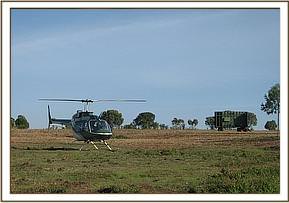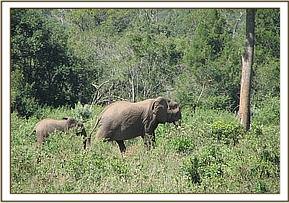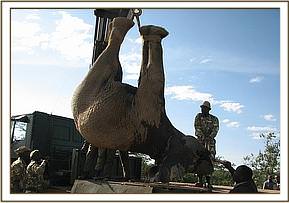The Masai Mara is home to the greatest and most spectacular ungulate migration in the world. Millions of Wildebeests accompanied by Zebras, Thomson Gazelles, Topis and followed closely by numerous Carnivores and birds of prey all cross manmade and Natural barriers to get to the rich savanna grassland of Masai Mara annually. This therefore ranks Masai Mara as one of the prime game viewing areas in the world in terms of sightings and game diversity.
The general Mara ecosystem hosts approximately 3072 Elephants. These Elephants are able to freely move in and out of the protected area without any hindrance and therefore their survival is supported heavily by the neighboring community lands, conservancies and ranchlands. Considering the threats facing the African Elephant today, every effort is being made and should be made to conserve and protect every one individual for the survival and wellbeing of this vital species that stands as the largest terrestrial mammal.
Another small population of 225 Elephants is basically cut off from the rest of the Elephants by increased human activities in the Narok North area. Initially all Maasais practiced pastoralism and therefore there was never any conflict with humans. But not any more. Times have changed with population increase resulting in a change of way of life and therefore changing land use. Therefore most Maasais in this area are now farmers and most of the forests have disappeared all together. This has exacerbated the Elephant-Human conflict whereby this isolated population strays onto the farmlands every time they venture out of the bushes.
The collaring of two Matriarchs in June 2011 showed that these Elephants are always hovering near the many parcels of maize and wheat farms. Clearly these Elephants had no future in these tiny pockets of bushes sandwiched between vast farmlands.
A major decision had to be made to save these elephants from further conflict with humans in the area. And the most practical solution was to move them out of these farmlands to the Masai Mara where they would have a better chance of survival.

Equipment.
Three days before the maiden capture, all the necessary equipment was transported to the capture site and a camp was put up to host the capture teams. This consisted of tents of various sizes to accommodate people and also shelter the various pieces of equipment from the vagaries of weather.
The area where this isolated population of elephants resides is hilly and characterized by very difficult terrain. There are a number of streams that emanate from the Mau forest on the west and they are deep and forested providing perfect cover for these elephants. This makes it nearly impossible to access them by a vehicle.
Mentioned below are the various pieces of equipment and their uses in the operation.
Fixed Wing Four Seater Aircraft
This small single engine aircraft is used for spotting the location of the elephants.
A message is relayed to the darting team which is stationed in a Bell helicopter.
Helicopter
This KWS Bell Helicopter comes in handy since it can fly very low in the rugged terrain enabling the vets to get clear shots of the Elephants on the ground. Its also used to drive the darted animals out of the thick bushes onto more accessible areas.


Lifting Cranes
These Cranes mounted on open Lorries lift the narcotized elephants from the ground onto the lorry which transports the Elephant to a stationary recovery crate.
Recovery Crate
This crate is stationed at a strategic point. It has steel doors which are locked once the elephant is revived from anesthesia.
Transport Lorries
These Heavy trucks move the Elephants to their new home. The Elephants are transported inside a crate that can carry a family of up to Twelve Elephants.
Pick Up Trucks
These four wheel drive pick ups move the ground teams that include Vets, Capture rangers and all other personnel to where narcotized Elephants are lying. These teams must arrive at these locations in the least time possible.
Excavator
Its mainly used to make a way for the ground teams including the lifting Cranes in case of inaccessible areas.
Procedure.
The Vets prepare the darts at daybreak. Various doses are prepared according to the varying ages and sexes of the elephants. This is mainly for juveniles, sub adults and adults. These darts are then marked accordingly.
Early in the morning at six, the fixed wing aircraft takes to the skies with a spotter and an Elephant research scientist. They relay the information about the location and sizes of all the elephant families they spot in the area.
Once this information is received the ground teams move closer to where the elephants are. The helicopter carrying the Vets and another Elephant research scientist takes to the skies to the location of the elephants.
The lifting cranes and the Pick up trucks with the ground teams wait at a safe distance.
Once the Elephants have been successfully darted and fully narcotized the capture rangers with the ground vets/teams quickly get to the scene.
Thereafter the lifting cranes are directed to the scene to commence loading and transport to the recovery crate for revival and loading in to the transport crate.
The Diaries
Day 1- On a Monday afternoon, we arrived at the Siyapei camp which is about 100 Kilometers from Masai Mara and put up our tents.
Day 2- Early the following morning, the spotter plane takes off and many elephants are spotted close to the camp.
The helicopter takes off and starts encircling the elephants in a bid to dart them. A mother and calf run away from the main family group running past our tents but is successfully darted. The rest of the family group runs deep in to the bushes and freeze. Due to sweltering heat the operation is called off for that day and the mother and its calf are driven to the Masai Mara national reserve. Both are successfully released in the reserve.


Day 3- This is the second day of capture. All the teams wake up early in the morning and the capture starts earnestly. Three bulls are spotted feeding nearby a family. A decision was made to capture the three bulls and try capturing the family on another day.
Day 4- This is the third day of capture. The spotter plane spots a family of Seventeen bulls and five are successfully captured and translocated to Masai Mara. The Kenya Wildlife Service Director is at hand to flag off the translocation lorries and therefore officially launch the exercise.
Day 5- On this day no capture takes place. Mechanics takes the day to service and repair various vehicles and machines involved in the exercise.
Day 6- On this day a Matriarch and her family of six were captured and driven to Mara. They are all successfully released at the Ol Keju Ronkai releasing site and it gratifies everyone to see them all dashing out of the transport crate in perfectly excellent condition.


Day 7- This is the Seventh of capture. All teams are upbeat and the capture begins. The elephants are now accustomed to the clutter of the planes above their heads and this daily noise interrupts their peace. A Matriarch and her family of six are spotted and they become a target for the days capture. They are all successfully darted but they retreat deep into the bushed galleys. Access to two elephants become practically impossible due to the deep gulley and thick forest and they are revived and let go to avoid complications that sometimes develop especially on animals under narcosis! We therefore manage to capture four elephants out of a family of six.

Day 8-All teams take a break on day eight to repair and service machines.
Day 9- Both ground and air teams are upbeat and ready to take on the days challenges. A family of ten is the target for the day. One is a bull that is temporarily visiting the family so he is left behind when the family of nine is captured and driven to their new home in Mara. Bulls can only be moved alone or in bull groups since they are not attached to families for their whole life.
Day 10- Again another family of ten is captured and driven to Masai Mara. The family arrives safely and is successfully released at the Ol Keju Ronkai releasing site.
There is another family of elephants feeding nearby and hopefully these two families will live be friends and live together sharing the available resources of water and pasture.
Day 11- On this day, success was beckoning the capture teams when a family of ten elephants was spotted close to the camp and quickly darted and successfully loaded onto the transport crate. They all arrived at their destined location in good shape and released in to the reserve.
Day 12- On this day, another seven family members were captured and safely transported to Masai Mara.
Day 13- By this day, heavy rains started pounding the area rendering most of dirt roads impassable. Nevertheless the capture went on and two bulls in the area were successfully captured and driven to the Mara.
Day 14- This is the final day of the capture. To sum it up all four family members are captured and taken to the Mara.
At the end of operation, sixty two elephants in total were captured, transported and successfully released in the Masai Mara.
Some selected individuals were fitted with GSM-UHF collars to enhance post translocation monitoring. This would enable the monitoring teams to easily locate the whereabouts of the elephants and see to it that they all settle down in the protected area of the reserve.
During the exercise all individuals were marked with a white paint on the backside for ease of identification from the ground or from the air. In addition all individuals were also marked with a loose dark tie on the tail for identification in case of post translocation mortality.

Blood samples are also taken for analysis of various clinical and biological parameters in the animals including for DNA analysis.
This marked the end of phase one of the translocation exercise with phase two expected to commence in a few months time once all the necessary drugs for immobilization have been procured. Phase will therefore target a total of between 160-170 elephants to be moved out of the area.
At the David Sheldrick Wildlife Trust we expect and hope that this exercise will help ease or eliminate human-elephant conflict in this area and will greatly help the locals to carry out their farming activities with no fear of attacks from elephants or elephants destroying their crops in the fields. At the same time this isolated population of elephants will have the space and resources they so need for their wellbeing in the wild.
Thank you all for the support you have offered to this important mobile vet unit operating in the Masai Mara for the wellbeing of our wild kin in this part of the globe.
Thank you.
Micheni Felix- Mara Vet Unit.

















